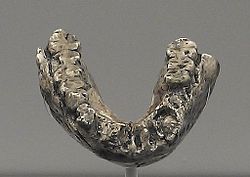 | |
| Catalog no. | LH 4 |
|---|---|
| Common name | Laetoli Hominid 4 |
| Species | Australopithecus afarensis |
| Age | 2.9–3.9 million years |
| Place discovered | Laetoli, Tanzania |
| Date discovered | 1974 |
| Discovered by | Mary Leakey |
LH 4 or Laetoli Hominid 4 [1] is the catalogue number of a fossilized mandible which was discovered by Mary Leakey in 1974 from Laetoli, Tanzania. [2]
Contents
Mary Leakey and her team, including Tim White, [3] found between 1974 and 1977 forty-two hominid teeth associated with a jawbone. One of them was LH-4, a fine specimen with nine teeth. White described the fossils, and LH-4 was assigned as the "name-bearer" of the new species Australopithecus afarensis by Don Johanson and White. [3]